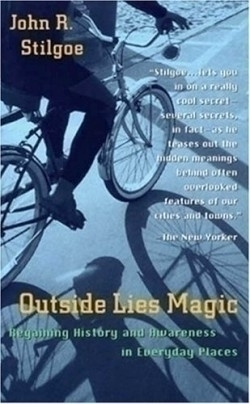Outside Lies Magic
Regaining History and Awareness in Everyday Places
On Zeandale Road in the Flint Hills of eastern Kansas, I can look out over the prairie and grain fields on either side of the road and see just a few hundred yards away the remnant of the right of way of the long-vanished Manhattan, Alma, and Burlingame Railroad. On the open flat fields it remains as a gentle dike.
Through a clump of trees next to a creek, I see an old iron bridge where the trains once ran, now the crossing to a farmhouse on the hillside. Long ago, at the quiet urging of my father, I learned to look around—up, out, down—to see the unexpected, the unusual, the footprints and traces and sights and sounds of what was, as well as the remarkable but often unnoted of what is.
Now comes Harvard University’s John R. Stilgoe, the school’s Orchard Professor of Landscape Architecture, with his latest book, Outside Lies Magic. It is a brilliant little lifestyle treatise—a handbook—on how to make your life more exciting here in the waning moments of the 20th century by learning to explore. Real exploration. Exploration that’s available to everyone, at no cost, no risk.
These explorations aren’t the Cousteau-inspired depths of the sea or the Hillary ascent of Mount Everest. These are the explorations of mundane things: telephone poles, utility lines, cracks in sidewalks, dapples of sunlight, shadows, rain, smoke, clouds, leaves, ants, sewer lines, buses, cars, reflections in store windows, sinuous curves of asphalt, bricks, fences, foundry names on manhole covers. In Stilgoe’s guidebook to our unobserved world, nothing can escape the questing eye.
“Exploration is a liberal art,” writes Stilgoe, “because it is an art that liberates, that frees, that opens away from narrowness. And it is fun.”
Stilgoe is an antidote. Outside Lies Magic ought to be a gift to every child (and ex-child). Whimsy, meandering, randomness, indirection, spontaneity, serendipity, are words that inhabit Stilgoe’s philosophy. You say we don’t have time for this today?
““And maybe exploring ordinary landscape shakes, then shatters the walls that direct the thinking of so many Americans now, both children and adults, the victims of advertising and television and computer networks and scheduled school and work. Risking the shattering of those walls is worth all the risks of going for a long, careful walk, for riding a bicycle down a different street, for seeing what no one photographs, for noticing what no one realizes.””
Reviewed by
David Hacker
Disclosure: This article is not an endorsement, but a review. The publisher of this book provided free copies of the book to have their book reviewed by a professional reviewer. No fee was paid by the publisher for this review. Foreword Reviews only recommends books that we love. Foreword Magazine, Inc. is disclosing this in accordance with the Federal Trade Commission’s 16 CFR, Part 255.

